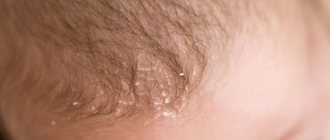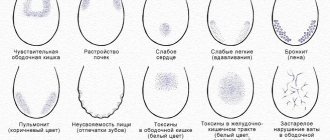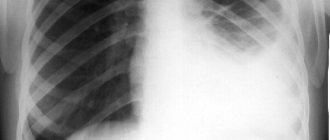Varieties of black coating on the tongue
Until recently, the discovery of a black coating on the tongue was perceived as infection with cholera. This disease is a thing of the past, but the symptom appears in people with enviable regularity. The causes of this phenomenon are varied, as are the symptoms.
Black plaque may appear on the following parts of the tongue:
- tip;
- root;
- On the sides;
- on the middle part (in the middle).
The plaque can be uniform, equally colored over the entire area of the organ, or appears in the form of “ripples”, giving the tongue a spotty appearance. one or two dark spots on it
, located in certain places. Experts also diagnose a general darkening of the organ, when its entire mass becomes gray, as if dirty in appearance.
Often, a dark coating on the tongue is combined with other signs of an existing disease, including heartburn, bitter taste in the mouth, ulcers and ulcers and many other symptoms.
In adults and children, the tongue may develop black spots - specks
, randomly distributed over the entire surface of the mucous membrane. These small black dots can signal fungal and other pathologies of the body and are often accompanied by damage to the gums or the entire oral cavity.
What it is
The tongue, like any other human organ, is covered with a layer of epithelium, which has a different structure depending on where it is located.
The lower side of the tongue is smooth, the upper is rough, and there are small papillae on it, thanks to which a person distinguishes various tastes. A normal healthy tongue is pink, the surface of the papillae has a whitish-grayish tint. After eating, tiny particles of food can get stuck between the papillae, in which bacteria begin to multiply. It is food particles and bacterial waste products that form the basis of plaque, which usually forms on the tongue some time after eating. It can be of various densities and shades. For example, the tongue becomes coated after drinking black coffee or chocolate. It is easily removed using the hygienic procedure of brushing the teeth and tongue, and it does not appear in the future. But if plaque is difficult to remove and soon appears again, you need to pay close attention to your health. Let's try to figure out in more detail what this brown coating on the tongue is.
Banal reasons for plaque on the tongue
Before you worry and look for the reasons for the appearance of a black tongue, the symptoms of which disease are present, you should carefully examine the oral cavity. You should also remember whether you used coloring products, such as:
- blueberry;
- red wine;
- mulberry;
- food with dark dyes;
- lollipops, etc.
Black tongue is often observed after taking activated carbon tablets.
, and in this case there is definitely no need to panic. You should perform high-quality oral hygiene, and you can forget about the problem.
Among the simple and common, but more serious causes of organ darkening, alcohol abuse
. They not only stain the tongue, but also provide the body with chronic intoxication, disrupting metabolism and slowing down the rate of elimination of toxins.
Gray plaque with black streaks may be the result of poor oral hygiene, in which case the symptom is accompanied by an unpleasant odor. Another popular reason why there is a black coating on the tongue is the active proliferation of mold fungi
after taking antibiotics. When local immunity is weakened, these microorganisms colonize the mucous membrane and give it a dark tint.
False concern
In the process of diagnosing serious illnesses, the most important thing is to exclude the manifestations of false plaque, which can appear under the influence of completely different factors and is considered the norm:
- activated carbon is a medicine that, if used repeatedly, gives a permanent color;
- confectionery caramel, when it contains dark food colorings;
- some types of fruits, in particular blueberries;
- sweet drinks, compotes, juices;
- ingestion of fragments of ink, felt-tip pens and other writing components (mainly in children).
Gastrointestinal diseases and black tongue
Blackening of the mucous membrane of the tongue in children is almost always associated with pathologies of the digestive system. In adults, the incidence of such problems in the presence of black plaque is lower
, and yet
gastrointestinal
occupy a leading position.
The symptom is more common in people who abuse fast food, baked goods, carbohydrate foods
, food with an abundance of preservatives, dyes, and other harmful additives. Such a “diet” leads to metabolic disorders, and the tongue serves as an indicator of general ill-being.
In Crohn's disease, the tongue turns black
, since an increase in melanin production occurs in the body due to suppression of the adrenal glands. Diseases of the gallbladder, stomach, and duodenum also cause changes in the oral cavity, and only their treatment will help get rid of the scourge.
Signs of the main pathologies of the gastrointestinal tract, accompanied by the appearance of a dark coating on the tongue, are shown in the table.
| Disease | Tongue symptom |
| Crohn's disease | Dark black or black-blue stains, especially noticeable in the morning, cannot be removed |
| Gastritis, stomach ulcer | Black and yellow plaque |
| Cholestasis, cholecystitis | Yellow spots with black streaks |
| Inflammation of the pancreas | Dark middle of tongue |
Hyperpigmentation
Brown spots on the tongue of an adult may occur due to hyperpigmentation. This happens due to the high concentration of melanin in the body. It is this substance that colors hair, eyes, and skin. If a large amount of melanin accumulates in the tissues of the tongue, harmless dark spots begin to appear. Hyperpigmentation of the tongue is caused by melanocytes - pigment cells.
However, sometimes brown spots on the tip of the tongue, caused by hyperpigmentation, are evidence of the development of melanoma, a type of cancer. Typically, melanoma develops under exposure to UV rays from the sun. The risk group includes people over 40 years of age, in particular women. As a rule, melanomas are brown or black in color, however, they can also be purple, red, or pink.
A photo of a brown spot on the tongue is presented.
Traditional medicine involves removing pigmentation using a laser. In folk medicine, rosehip, aloe vera, cucumber, lemon, and potato juices are used to lighten darkened tongue and skin.
Melanin production is reduced by hydroquinone. It contains calcium, kojic and azelaic acids, cucumbers, soy milk.
Inflammatory pathologies of the oral cavity
Pharyngitis or chronic tonsillitis
in the acute stage, they can also lead to the appearance of a black “sediment” on the tongue. Its distinctive feature is its presence after waking up and its almost complete disappearance after eating or hygienic cleaning.
Sometimes a black coating appears on the tonsils and tongue in combination with an increase in body temperature. Such symptoms are characteristic of tonsillitis (acute tonsillitis). Sore throat does not occur without a sore throat, so making a diagnosis in such a situation is quite simple. When the disease passes, the unpleasant manifestations of the tongue will also disappear.
Sometimes black spots form after suffering from the flu - this is how glossitis, or inflammation of the tongue, occurs.
Oddly enough, sometimes a black tongue means the development of oral candidiasis, or thrush
. Typically, this pathology manifests itself as white cheesy masses localized in the mouth, but advanced stages cause darkening of the plaque. The disease is accompanied by bad breath, burning, tingling, and tissue swelling.
Prevention
Regardless of what was the root cause of this phenomenon, in order to prevent its recurrence in the future, standard hygiene measures should be regularly carried out to prevent the proliferation of pathogenic microbes.
This is discussed in the following video:
If the pathology has already begun to manifest itself, urgently change your toothbrush and other hygiene products. After each use, treat them with soap. And, of course, cleaning the organ itself.
For this purpose, various devices have been specially developed to make the care procedure simple and convenient. If you don’t have anything at hand, you can use a regular spoon to carefully remove the plaque.
Other causes of black plaque
The appearance of this symptom cannot be ignored - it often means big health problems. For example, the body may suffer from acidosis - a buildup of toxins and a shift in the acid-base balance towards oxidation. This condition can be caused by long-term infections, intestinal disorders, and starvation diets.
Other possible causes of the pathology are as follows:
- Lead poisoning
. Acute lead intoxication almost always manifests itself as changes in the oral cavity. - Inflammatory and chronic diseases of the lungs and bronchi
. Some bacteria cause the tongue to turn a frightening shade; after recovery, the color returns to normal. - Taking certain hormonal medications
. Canceling medications helps the unpleasant color of the mucous membrane disappear. - HIV and other severe types of immunodeficiency
. With such pathologies, there is sometimes a black-gray plaque in the mouth. - Dehydration
. With an acute form of lack of fluid in the body, the tongue may change color to dark.
Infants sometimes develop a dark coating after the introduction of the first complementary foods, if until that moment the baby was fed only breast milk - as a reaction to a new product. There is also a separate pathology - “black hairy tongue”, in which papillary outgrowths grow on the organ, become dark and hard. The exact reasons are not clear, but the disease most often appears in smokers.
The child has
Any competent specialist can, with a high degree of probability, diagnose a particular pathology based on the condition of the tongue. But this is not always the case with a child’s body.
This method of identifying the disease in pediatrics is considered auxiliary, since, for example, ordinary foods that the baby has eaten without the parents noticing can change the color of the pigment.
Black plaque in a child can be caused by:
- taking iron-containing drugs in liquid form;
- treatment of respiratory and infectious diseases, when certain groups of drugs that can give such a side effect were used as therapy;
- candidiasis and dysbacteriosis are often the causes of pathology.
As a rule, this phenomenon does not cause any particular discomfort in the child, except perhaps some dryness and, in rare cases, itching.
We will tell you how to quickly get rid of caries at home in a separate article. By clicking on the following link: https://dentist-pro.ru/lechenie/bolezni-polosti-rta/stomatit-bpr/natriya-tetraborat.html - you will find detailed instructions on the use of sodium tetraborate for stomatitis in a child.
And here you will find out whether it is possible to treat a fistula on the gum with antibiotics.
Diagnosis of pathology
Dark plaque is not a specific disease, but a symptom, so it is important to see a doctor to find the cause. It’s better to start by going to a therapist, who will prescribe a number of necessary tests, but will be able to suggest a diagnosis based on the appearance of the oral cavity and additional signs. For example, if plaque appears in the form of dots, this is a sign of a fungal infection or damage to the gastrointestinal tract; large spots of plaque signal pathologies of the gallbladder and pancreas.
The examination program for such a problem is as follows:
- A general blood test
will show the inflammatory process, the presence of bacterial infections; - Bacterial culture from the oral cavity
will reflect the specific type of pathogen, including the type of fungal infection; - Blood biochemistry
– diagnoses pathologies of the hepatobiliary system, pancreas; - Coprogram, occult blood test
- necessary to identify intestinal diseases; - FGS, colonoscopy
- needed to clarify diseases of the gastrointestinal tract.
Shades of dark color
The color of the tongue can really tell the doctor a lot about the condition of the patient's body. Dark masses on a muscular organ with various ailments have a certain shade.
- A signal about diseases of the digestive system, immunodeficiency, and hormonal imbalances is given by the dark green color of the tongue.
- Dark brown deposits occur with fungal infections, food poisoning, pulmonary diseases, as well as with hemolysis and adrenal insufficiency.
- Dark red deposits appear with scarlet fever, kidney infection, and advanced glossitis.
- With serious damage to the stomach and intestines, the plaque becomes dark gray.
- A black tint suggests cholera.
In addition, Crohn's disease is indicated by black spots on the receptor organ. Black deposits with an acetone odor indicate severe dehydration. Dark substrate and inclusions on the crowns indicate a chromogenic fungal disease. Any therapeutic program, as a rule, includes hygienic cleaning of the oral cavity. In our center it is performed by highly qualified hygienists.
Treatment of black tongue
There are no uniform recommendations on how to remove plaque from the mucous membrane. Usually, the treatment measures recommended by a specialist for the underlying disease are sufficient, and the entire area of the tongue is cleared and returns to its normal color. In case of acidosis, it is prescribed to drink more fluids and take alkaline mineral water. Inflammatory pathologies are treated by rinsing with antiseptics and taking antibiotics orally. Fungal infections are treated with antimycotics - tablets and drops on the tongue.
Only after a complete examination is treatment selected; independent therapy is unacceptable.
Gastrointestinal diseases are eliminated by correcting nutrition and taking medications:
- antisecretory agents;
- antacids;
- bile thinners;
- herbal choleretic agents;
- enzymes, etc.
It is also important to carry out regular oral hygiene 2-3 times a day, drink kefir and other fermented milk
to normalize intestinal flora, stop smoking and alcohol. At home, you should rinse your mouth with infusions of sage, lemon peels (a tablespoon per glass of water), saline solution with tea tree oil (a teaspoon of salt and 5 drops of oil per glass of water). This will speed up getting rid of black plaque and prevent relapse.
Treatment of dark plaque
Patients with dark deposits on the muscle organ are advised to systematically treat their teeth. This will help avoid unpleasant symptoms. Oral hygiene procedures are mandatory. You should clean not only your incisors and molars, but also your tongue twice a day. You can use a special scraper and gels. It is important not to injure mucous tissues. Treatment of acidosis begins with drinking plenty of fluids.
Of course, it is impossible to get rid of dark layers if the underlying disease is not treated. Therapy is prescribed individually based on the established diagnosis.
- For stomatitis, you should rinse your mouth with a liquid containing antiseptics such as Hepilor or Chlorophyllipt.
- Antifungal agents eliminate candidiasis. These are Clotrimazole, Pimafucin, Fluconazole.
- The microflora in the intestines is restored by probiotics with bifidobacteria and lactobacilli. Most often, Linox and Acipol are prescribed.
- Prebiotics stimulate the body's production of its own beneficial bacteria. The nutrient medium for them is created by Duphalac and Lactusan.
- The body's defenses are increased by Cycloferon, Kagocel, Ribomunil.
- The secretion of gastric juice is stimulated by Limontar and Etimizol, which is important for low acidity.
- Aggressive gastritis is treated with antibacterial drugs, in particular Cephalexin.
- Toxic substances are well removed by a sorbent such as Enterosgel.
If the patient complains of heartburn, he is prescribed Rennie, Maalox and other medications. The gastric mucosa is well protected by De-Nol and Venter. Deficiency of vitamins PP and group B is eliminated by taking vitamin complexes. Dietary nutrition is often prescribed. The program is developed for each patient individually.









